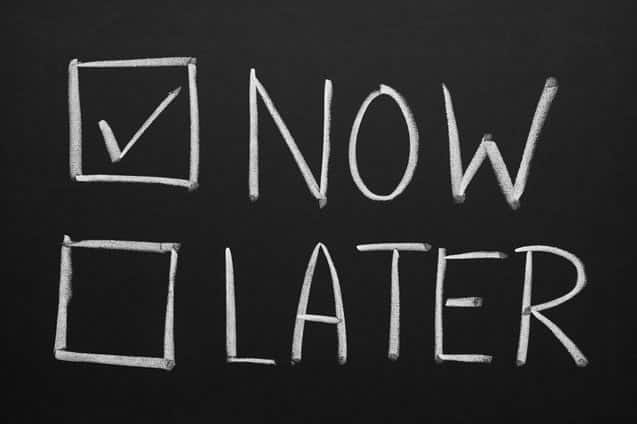Are you spending your day doing what matters most to you? Could you tell me what your most important tasks are for tomorrow or next week?
How about your goals for the year, have you made progress on them? Are they simply big nebulous things like ‘get in shape’ or ‘earn more money’ or have you taken the time to break them down in to steps?
If you don’t like the answers to those questions here are 3 things you need to start doing to take control of your productivity.
3 Ways To Take Back Control of Your Time
Start with the Zorro Circle
In The Happiness Advantage, Shawn Achor talks about the Zorro circle. The Zorro Circle is the smallest thing that you can take control of so you build on a success. Many of us set goals for the year and then spend the year trying to achieve that large fairly nebulous goal. Somehow we’re surprised that it didn’t get accomplished when we look back, but we shouldn’t be.
It’s no wonder that fitness facilities see a huge drop off in the first few months of the year when people simply put the goal of ‘get in shape’ on their calendar. What does ‘in shape’ mean? Does it involve eating as well or just weight lifted and miles run? Where does one even start to get in shape?
Make a big goal of getting in shape but then take control of one easy thing. Set out your gym clothes the night before and put them on the in the morning. Successfully putting them on first thing is easy and it sets you up for success. You’ve built some momentum and are energized to keep that success momentum going.
Don’t just make a yearly goal. Break it down in to quarters. Then break those down in to achievements for the month. Break that down further in to small tasks you can easily accomplish. Build on those tasks and at the end of the year you’ll see accomplishment in your wake.
The week before
Once you’ve got things broken down in to small units it’s time to start planning for the week. You know what needs to get done in the next few weeks because you broke your big goals down but now it’s time to decide when you can get them done.
A Getting Things Done practice is the weekly review. Even if you don’t subscribe to all the GTD methods, this one is awesome. Every Friday (or whatever day of the week works for you) sit down and go through all your inboxes and clear them out. Clear off your desk and spend some time writing down all the little tasks you want to accomplish. Look through every project that is in your area of responsibility and review the tasks that need to be accomplished to move the projects forward.
Now with everything out of your head and with your calendar in front of you plan out what day you’re going to tackle the tasks for next week. Doing this means that each week you can see progress towards your goals and that continues to build on the success you’re already having.
While this is the most important part of a solid GTD system it’s also the first thing to go in most busy schedules. Some meeting gets called or some client has an emergency and the weekly review gets tossed out the window. Don’t let that happen. Actually mark your review out as a meeting and stick to it. I know the weeks I don’t get my review in I see a 15 – 20% drop in how much I get done. When I get my coaching clients to plan out their week they always come back excited about how much they got done and continue to get done as they start their week with intention.
One key mistake that many people make in their weekly planning is to schedule their time down to the minute with no margin. This means that when the inevitable wrench gets thrown in a day there is no time to absorb the issue.
Always leave at least 10% of your day unscheduled. I plan my writing time for around 3 hours a day but only 90 minutes of that is time that I devote only to writing. The rest is there for overflow work that comes up. At least 2 days a week I get my full writing time in, the rest of the week I get 90 minutes and use the extra time for that overflow that happens.
The day before
As we just said no plan survives the busy week we all lead so you can’t just plan on Friday and hope it all turns out as you predicted. While leaving 10% of your day available for those fires helps accommodate them you need to continue to adapt your plan as the week happens. That adaptation is what should end every day.
Spend the last 15 minutes of your day reviewing what you have on your plate for the next day. Take a look at your calendar and your task management tool of choice. Then flag the most important task of the day so it rises to the top.
Before you do anything in the morning get your top task done. Don’t open your email, just get that task done then see what others have in store for you that day.
It’s much to easy to be passive with our work. We come in to the day and spend all our time putting out fires. We respond to emails as the come in and end the day exhausted. When we look back at that frenetic day we can’t identify anything meaningful accomplished. Likely none of our big goals were pushed forward at all. By marking out your most important task of the day the night before and not dealing with any email or fires till you’ve worked on it you’ll push your important projects forward every day.
It’s up to you to take control of your work and your effectiveness. You can do this by taking those big goals and big projects and breaking them down in to small bites. Then plan those small bites out in to your weeks and your days. Flag that important task and don’t do anything else until it’s done.
That’s how you’re going to keep pushing forward on your goals. Simply hoping it happens in the midst of a crazy week is a recipe for failure. Hope is not a strategy.
Photo credit: Unsplash.com





